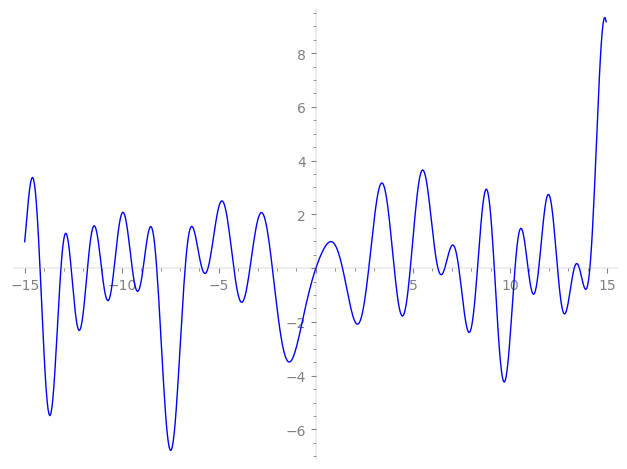| L(s) = 1 | + (−0.866 + 1.5i)3-s + (−2 + 3.46i)7-s + (−1.5 − 2.59i)9-s + (−0.866 − 0.5i)11-s + (3.46 − 2i)13-s − 7·17-s + 5i·19-s + (−3.46 − 6i)21-s + (−2 − 3.46i)23-s + (−2.5 + 4.33i)25-s + 5.19·27-s + (3.46 + 2i)29-s + (−4 − 6.92i)31-s + (1.5 − 0.866i)33-s − 8i·37-s + ⋯ |
| L(s) = 1 | + (−0.499 + 0.866i)3-s + (−0.755 + 1.30i)7-s + (−0.5 − 0.866i)9-s + (−0.261 − 0.150i)11-s + (0.960 − 0.554i)13-s − 1.69·17-s + 1.14i·19-s + (−0.755 − 1.30i)21-s + (−0.417 − 0.722i)23-s + (−0.5 + 0.866i)25-s + 1.00·27-s + (0.643 + 0.371i)29-s + (−0.718 − 1.24i)31-s + (0.261 − 0.150i)33-s − 1.31i·37-s + ⋯ |
\[\begin{aligned}\Lambda(s)=\mathstrut & 1152 ^{s/2} \, \Gamma_{\C}(s) \, L(s)\cr =\mathstrut & (-0.422 + 0.906i)\, \overline{\Lambda}(2-s) \end{aligned}\]
\[\begin{aligned}\Lambda(s)=\mathstrut & 1152 ^{s/2} \, \Gamma_{\C}(s+1/2) \, L(s)\cr =\mathstrut & (-0.422 + 0.906i)\, \overline{\Lambda}(1-s) \end{aligned}\]
Particular Values
| \(L(1)\) |
\(=\) |
\(0\) |
| \(L(\frac12)\) |
\(=\) |
\(0\) |
| \(L(\frac{3}{2})\) |
|
not available |
| \(L(1)\) |
|
not available |
\(L(s) = \displaystyle \prod_{p} F_p(p^{-s})^{-1} \)
| $p$ | $F_p(T)$ |
|---|
| bad | 2 | \( 1 \) |
| 3 | \( 1 + (0.866 - 1.5i)T \) |
| good | 5 | \( 1 + (2.5 - 4.33i)T^{2} \) |
| 7 | \( 1 + (2 - 3.46i)T + (-3.5 - 6.06i)T^{2} \) |
| 11 | \( 1 + (0.866 + 0.5i)T + (5.5 + 9.52i)T^{2} \) |
| 13 | \( 1 + (-3.46 + 2i)T + (6.5 - 11.2i)T^{2} \) |
| 17 | \( 1 + 7T + 17T^{2} \) |
| 19 | \( 1 - 5iT - 19T^{2} \) |
| 23 | \( 1 + (2 + 3.46i)T + (-11.5 + 19.9i)T^{2} \) |
| 29 | \( 1 + (-3.46 - 2i)T + (14.5 + 25.1i)T^{2} \) |
| 31 | \( 1 + (4 + 6.92i)T + (-15.5 + 26.8i)T^{2} \) |
| 37 | \( 1 + 8iT - 37T^{2} \) |
| 41 | \( 1 + (1.5 + 2.59i)T + (-20.5 + 35.5i)T^{2} \) |
| 43 | \( 1 + (-0.866 - 0.5i)T + (21.5 + 37.2i)T^{2} \) |
| 47 | \( 1 + (-2 + 3.46i)T + (-23.5 - 40.7i)T^{2} \) |
| 53 | \( 1 + 8iT - 53T^{2} \) |
| 59 | \( 1 + (7.79 - 4.5i)T + (29.5 - 51.0i)T^{2} \) |
| 61 | \( 1 + (30.5 + 52.8i)T^{2} \) |
| 67 | \( 1 + (-2.59 + 1.5i)T + (33.5 - 58.0i)T^{2} \) |
| 71 | \( 1 - 8T + 71T^{2} \) |
| 73 | \( 1 + 3T + 73T^{2} \) |
| 79 | \( 1 + (4 - 6.92i)T + (-39.5 - 68.4i)T^{2} \) |
| 83 | \( 1 + (13.8 + 8i)T + (41.5 + 71.8i)T^{2} \) |
| 89 | \( 1 - 6T + 89T^{2} \) |
| 97 | \( 1 + (0.5 - 0.866i)T + (-48.5 - 84.0i)T^{2} \) |
| show more | |
| show less | |
\(L(s) = \displaystyle\prod_p \ \prod_{j=1}^{2} (1 - \alpha_{j,p}\, p^{-s})^{-1}\)
Imaginary part of the first few zeros on the critical line
−9.461342698668455602767829889671, −8.898487512258585555784143874386, −8.198703976599581314268013076944, −6.73559535660070100796950963029, −5.87032629960682260605032151483, −5.55833982843767662372845153475, −4.22785720497696196667211052070, −3.39659158085874796893480546075, −2.24266118522025334928963041377, 0,
1.37024506425538815992285015538, 2.72277130523598161042220954684, 4.03456380393944183725638612500, 4.86371209358299049337210215971, 6.28551888208523037909502203752, 6.63800177647304519237626200782, 7.36190361563683479198312413726, 8.323580349513391909798481000595, 9.189533806880480795637354018913

